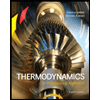
Concept explainers
a)
The amount of ice added.
a)
Answer to Problem 208RP
The amount of ice added is
Explanation of Solution
Write the expression for the energy balance equation for closed system.
Here, energy transfer into the control volume is
Write the expression to calculate the initial entropy of the refrigerant.
Here, initial entropy is
Write the expression to calculate the initial enthalpy of the refrigerant.
Here, initial enthalpy is
Write the expression to calculate the initial specific volume of the mixture.
Here, initial specific volume of the mixture is
Write the expression to calculate the mass of the stream
Here, the initial volume of a container is
Conclusion:
Substitute
Here, change in enthalpy in ice is
From the Table A-4, “Saturated water-Temperature table” the obtain the following properties at temperature of is
From the Table A-4, “Saturated water-Temperature table” the obtain the following properties at temperature of is
Here, the final entropy is
Substitute
Substitute
Substitute
Substitute
From the Table A-3, “Properties of common liquids, solids, and foods”, select the specific heat at constant pressure at room temperature for liquid and ice as
The melting temperature and the heat of fusion of ice at
Substitute
Thus, the amount of ice added is
b)
The entropy generation during the process.
b)
Answer to Problem 208RP
The generation during the process is
Explanation of Solution
Write the expression for the entropy balance equation of the system.
Here, rate of net entropy in is
Conclusion:
Substitute 0 for
Substitute
Thus, the generation during the process is
Want to see more full solutions like this?
Chapter 7 Solutions
Thermodynamics: An Engineering Approach
- Argon gas enters an adiabatic compressor at 14 psia and 75°F with a velocity of 60 ft/s, and it exits at 200 psia and 240 ft/s. If the isentropic efficiency of the compressor is 87 percent, determine the exit temperature of the argon.arrow_forwardIn a container with a fixed volume of 0.5 m3, initially there is refrigerant -134a at a pressure of 200 kPa and a dryness fraction of 40%. Later, heat is transferred from a source at 35°C to the refrigerant until its pressure rises to 400 kPa. Calculate the entropy changes of the system, the surroundings, and the universe during the phase change.arrow_forwardSteam enters an adiabatic turbine steadily at 7 MPa, 500°C, and 45 m/s and leaves at 100 kPa and 75 m/s. If the power output of the turbine is 5 MW and the isentropic efficiency is 77 percent, determine the rate of entropy generation during this process.arrow_forward
- A piston–cylinder device contains superheated steam. During an actual adiabatic process, the entropy of the steam will (never, sometimes, always) increasearrow_forwardA frictionless piston-cylinder device contains a liquid-vapor mixture of water at the temperature of 400K. During an internally reversible isobaric process, 800kJ heat is transferred out from the water, and part of the vapor condenses. The entropy change of water inside the piston-cylinder is________ A. -2.0 kJ/K B. 0 C. greater than 2.0 kJ/K D. 2.0 kJ/Karrow_forwardDetermine the final temperature when air is expanded isentropically from 1000 kPa and 477°C to 100 kPa in a piston–cylinder devicearrow_forward
- Refrigerant-134a enters the coils of the evaporator of a refrigeration system as a saturated liquid–vapor mixture at a pressure of 140 kPa. The refrigerant absorbs 180 kJ of heat from the cooled space, which is maintained at –10°C, and leaves as saturated vapor at the same pressure. Determine the entropy change of the refrigerant.arrow_forward3-kg of helium gas at 100 kPa and 27C are adiabatically compressed to 900 kPa. If the isentropic compression efficiency is 80 percent, determine the required work input and the final temperature of helium.arrow_forwardNitrogen gas is compressed from 80 kPa and 27°C to 480 kPa by a 10-kW compressor. Determine the mass flow rate of nitrogen through the compressor, assuming the compression process to be isentropic.arrow_forward
- Air is compressed from an initial state of 100 kPa and 17°C to a final state of 600 kPa and 57°C. Determine the entropy change of air during this compression process by using property values from the air table.arrow_forwardSteam at 3 MPa and 400°C is expanded to 30 kPa in an adiabatic turbine with an isentropic efficiency of 92 percent. Determine the power produced by this turbine, in kW, when the mass flow rate is 2 kg/s.arrow_forwardAir is expanded in an adiabatic turbine of 85 percent isentropic efficiency from an inlet state of 2200 kPa and 300C to an outlet pressure of 200 kPa. Calculate the outlet temperature of air and the work produced by this turbine per unit mass of air.arrow_forward
 Elements Of ElectromagneticsMechanical EngineeringISBN:9780190698614Author:Sadiku, Matthew N. O.Publisher:Oxford University Press
Elements Of ElectromagneticsMechanical EngineeringISBN:9780190698614Author:Sadiku, Matthew N. O.Publisher:Oxford University Press Mechanics of Materials (10th Edition)Mechanical EngineeringISBN:9780134319650Author:Russell C. HibbelerPublisher:PEARSON
Mechanics of Materials (10th Edition)Mechanical EngineeringISBN:9780134319650Author:Russell C. HibbelerPublisher:PEARSON Thermodynamics: An Engineering ApproachMechanical EngineeringISBN:9781259822674Author:Yunus A. Cengel Dr., Michael A. BolesPublisher:McGraw-Hill Education
Thermodynamics: An Engineering ApproachMechanical EngineeringISBN:9781259822674Author:Yunus A. Cengel Dr., Michael A. BolesPublisher:McGraw-Hill Education Control Systems EngineeringMechanical EngineeringISBN:9781118170519Author:Norman S. NisePublisher:WILEY
Control Systems EngineeringMechanical EngineeringISBN:9781118170519Author:Norman S. NisePublisher:WILEY Mechanics of Materials (MindTap Course List)Mechanical EngineeringISBN:9781337093347Author:Barry J. Goodno, James M. GerePublisher:Cengage Learning
Mechanics of Materials (MindTap Course List)Mechanical EngineeringISBN:9781337093347Author:Barry J. Goodno, James M. GerePublisher:Cengage Learning Engineering Mechanics: StaticsMechanical EngineeringISBN:9781118807330Author:James L. Meriam, L. G. Kraige, J. N. BoltonPublisher:WILEY
Engineering Mechanics: StaticsMechanical EngineeringISBN:9781118807330Author:James L. Meriam, L. G. Kraige, J. N. BoltonPublisher:WILEY





